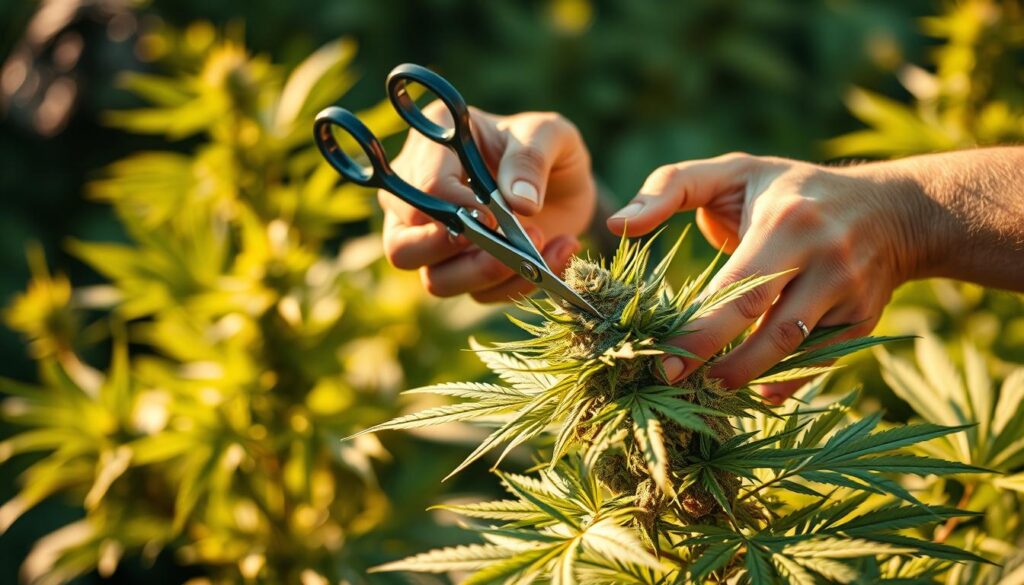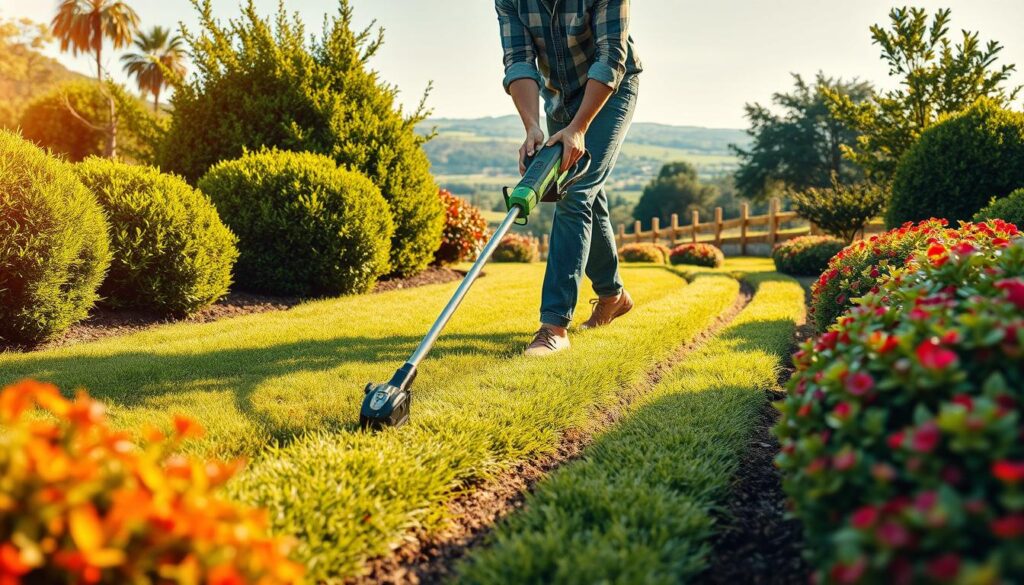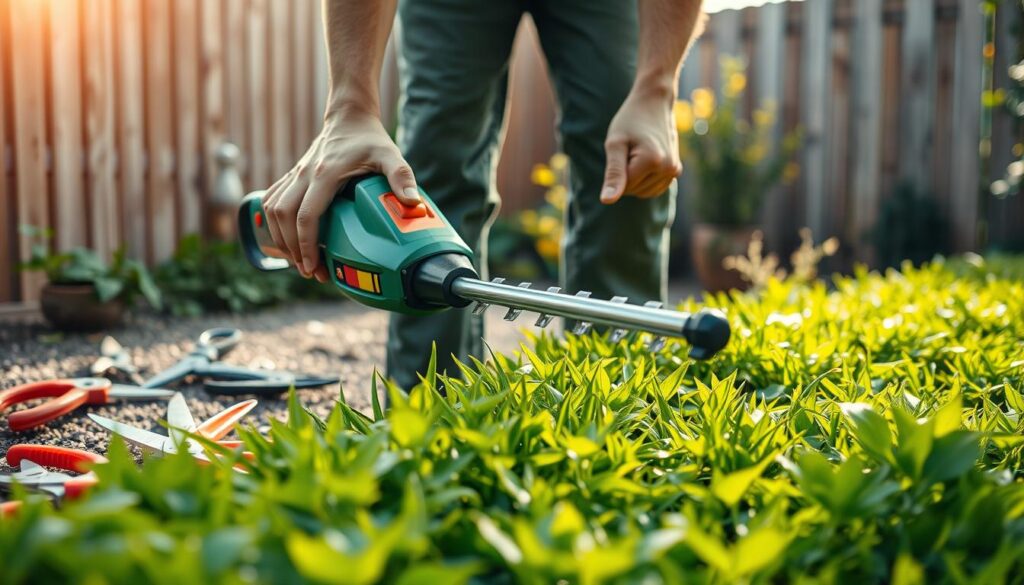Trimming your plants is more than just making them look good. It’s about making them taste better, smoke smoother, and be more potent. Whether you’re new to growing or have been doing it for years, learning weed trimming techniques is key. It makes sure every hit is perfect.
It’s not just about looks. Trimming buds right helps them cure better, burn cleaner, and taste more consistent. Using sharp scissors or pruning shears makes the job easier and keeps the buds safe. Follow a step-by-step guide to avoid mistakes that can make buds harsh or uneven.
Want to get better at trimming? We’ll show you how to pick the right tools, trim sugar leaves right, and get your buds ready for curing. By the end, you’ll know how to handle even the stickiest buds like a pro.
Key Takeaways
- Proper trimming enhances flavor, potency, and overall smoke quality
- Sharp tools preserve trichomes and prevent damage to buds
- Timing matters—trim too early or late, and you risk mold or lost potency
- Curing after trimming ensures even drying and smoother results
- Save trimmings for edibles or concentrates to maximize your harvest
Understanding the Importance of Weed Trimming
Trimming is more than making plants look good. It’s a science that affects their growth and quality. Whether you grow for yourself or work with a expert cannabis trimming team, the right techniques are key. They can turn average buds into top-quality ones.
Benefits of Regular Weed Trimming
Using sharp shears does more than just cut leaves. It makes buds look uniform and appealing. Trimming also makes buds burn smoother because it removes harsh chlorophyll from leaves.
You’ll also see:
- Higher THC concentration in focused growth areas
- Reduced risk of mold hiding in dense foliage
- Better airflow around buds during drying
How Trimming Supports Plant Health
Professional cannabis pruning is like directing traffic. It helps plants grow better by removing lower leaves. This forces energy to go up. Techniques like FIM (short for “F I Missed”) create more colas, helping plants:
- Focus on prime bud sites
- Grow stronger stems
- Stay away from pests
When to Trim Weeds for Best Results
Timing is everything. Dry trimming works best in humid climates to slow drying. Wet trimming is better in dry areas to prevent buds from drying out too fast. Here’s a comparison:
| Method | Best For | Ideal Humidity | Strain Type |
|---|---|---|---|
| Wet Trim | Quick-drying climates | Below 40% | Dense buds |
| Dry Trim | High-humidity areas | 50-60% | Airy sativas |
Always check your strain’s traits. Some hybrids need a mix of both methods. If unsure, ask a professional cannabis pruning service to avoid mistakes.
Choosing the Right Tools for Weed Trimming
The secret to a flawless trim lies in your toolkit. Whether you’re handling a small garden or a larger crop, quality equipment ensures precision and protects your plants. Let’s break down what you’ll need to trim and manicure cannabis plants effectively.
Essential Trimming Tools You Need
Start with these non-negotiable items for your efficient weed trimming process:
- Spring-loaded scissors: Fiskars models offer ergonomic designs that reduce hand fatigue during detailed work.
- Pruning shears: Ideal for thicker stems your scissors can’t handle.
- Micro-tip trays: Keep buds organized and catch trimmings for later use.
- Nitrile gloves: Prevent sticky resin from coating your hands.
Comparing Manual vs. Electric Trimmers
Manual tools excel in control, while electric options save time. Here’s how they stack up:
| Feature | Manual Trimmers | Electric Trimmers |
|---|---|---|
| Precision | High (ideal for delicate buds) | Moderate (better for bulk work) |
| Speed | Slower, methodical | 3x faster |
| Maintenance | Easy cleaning | Regular blade sharpening |
Safety Gear: Protecting Yourself While Trimming
Don’t skip these protective measures:
- Cut-resistant gloves: Avoid accidental nicks from sharp blades.
- Disposable hairnets: Keep loose hairs from contaminating buds.
- Isopropyl alcohol: Sanitize tools between plants to prevent disease spread.
Pro tip: Soak your scissors in alcohol for 10 minutes after each session. Residue buildup can dull blades and transfer unwanted compounds.
Mastering the Techniques of Weed Trimming
Getting good at trimming can make a big difference. It can turn a regular harvest into top-quality buds. These tips will help you trim better, whether it’s backyard weeds or cannabis.

Best Practices for Effective Trimming
First, pick the right method for your drying conditions:
- Wet trimming: Good for humid places. Cut leaves right after harvest with curved shears.
- Dry trimming: Best for slow curing. Hang whole branches for 7-10 days. Then, use precision snips to remove sugar leaves.
Always turn buds as you trim. Cut sugar leaves right where they meet the flower. “The goal is to enhance airflow without stripping protective trichomes,” says a weed bud trimming specialist from Colorado.
Common Mistakes to Avoid
New trimmers often make these mistakes:
- Over-trimming (“bud shaving”) that removes valuable resin glands
- Using dull tools that crush stems instead of making clean cuts
- Rushing through dense areas and creating uneven results
“Treat each bud like a tiny sculpture—remove only what’s necessary to reveal its natural shape.”
Tips for Dealing with Tough Weeds
For hard plants:
- Work in sections using sharp, stainless steel scissors to prevent sap buildup
- Save trimmed sugar leaves for making extracts or edibles
- Take breaks every 20 minutes to maintain focus and precision
For very dense growth, think about getting help from weed bud trimming specialists. They use special tools like electric defoliators. Many top weed trimming services now offer video consultations to help DIY gardeners with tough projects.
Maintaining Your Garden After Trimming
Trimming isn’t the end. What you do next keeps weeds away. Learn how to keep your garden clean and weed-free.

Cleaning Up Debris Post-Trimming
Clippings can attract pests or grow new weeds. Bag non-usable plant matter tightly. Dispose of it away from your garden.
For cannabis or herbs, you can use trimmings in different ways:
- Turn small leaves into compost tea
- Dry larger cuttings for cooking extracts
- Mix shredded stems into mulch
How to Mulch After Trimming
Mulching keeps moisture in and weeds out. Use the “lollipop method” for a 3-inch layer of shredded trimmings. Leave space near stems to avoid rot. Pro tip: Add straw for better air.
Preventing Regrowth of Weeds
Keep weeds from coming back with these tips:
- Dig out root systems completely using a dandelion weeder
- Plant fast-growing ground cover like clover
- Apply corn gluten meal as a natural pre-emergent
“Consistent maintenance beats heroic weeding sessions every time.”
Organic Options for Weed Control
Growing a healthy garden doesn’t need harsh chemicals. Simple, natural ways can keep weeds away while helping your plants. Start by looking into proven weed control techniques that work with nature.
Natural Herbicides Worth Considering
Vinegar-based sprays or corn gluten meal stop weeds without synthetic chemicals. These options break down safely in soil. They are great for edible gardens or areas where pets play. Some marijuana trimming services use similar organic principles to keep growing spaces clean.
The Role of Ground Cover Plants
Low-growing plants like clover or creeping thyme form living mulch. They block sunlight from reaching weed seeds. They also add nutrients to the soil. This method works well between vegetable rows or under fruit trees.
Companion Planting to Suppress Weeds
Strategic plant pairings create natural weed barriers. Fast-growing basil deters pests near tomatoes. Marigolds release root chemicals that inhibit weed germination. These partnerships reduce maintenance and boost biodiversity in your garden.
Combining these approaches creates a self-sustaining system. You’ll spend less time pulling weeds and more enjoying your thriving outdoor space. Whether managing a small plot or larger landscape, organic methods adapt to your needs while keeping ecosystems balanced. weed in Trim . weed in Trim. weed in Trim . weed in Trim . weed in Trim . weed in Trim .

